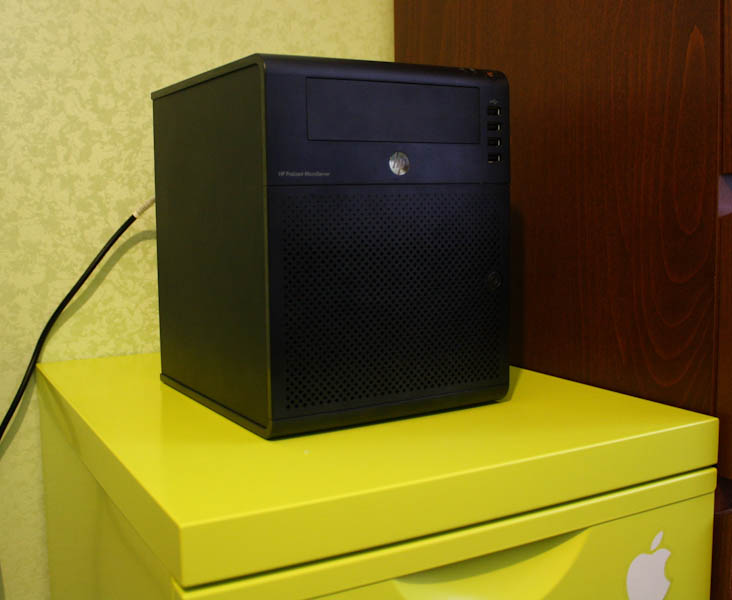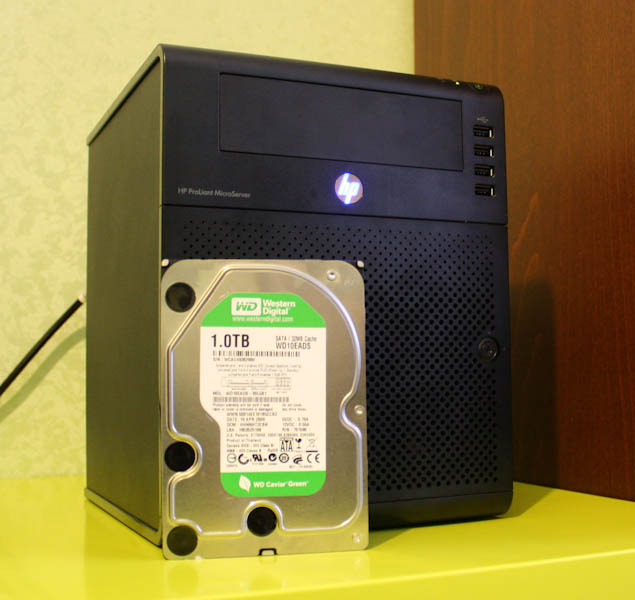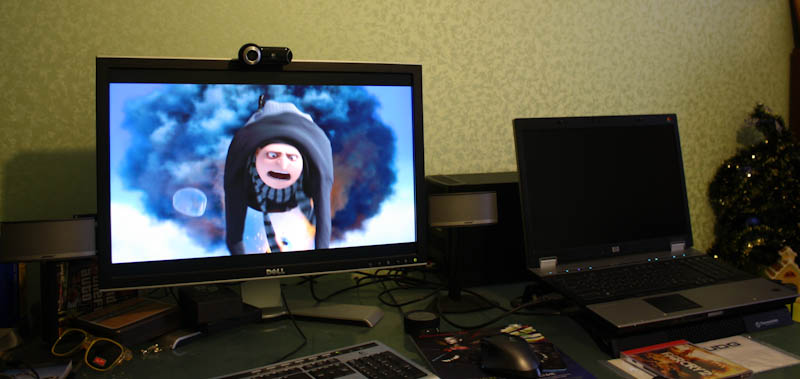HP Microserver at home
In the last post about how HP Microserver feels in the office, I promised to write a small sequel about how he would behave at home. Actually, here it is.

')
The first thought that arises when looking at the Microserver, at least for me, is the desire to fill it with disks and organize capacious storage for the video, having received a server in addition. For the first time this idea was voiced in the previous post, and some skeptical commentators indicated that for about the same money, which the “empty” Microserver costs, you can purchase a 4TB NAS Western Digital. Fully assuming that this is the case, I cannot but remind you that in the person of Microserver you can also get a spare home computer, for that matter. At least for mail, typing and simple browsing, it fits as well as a decent nettop. And from the NAS of such abilities can not wait by definition. So Microserver is quite able to make a backup option in case of failure of your main home horse. And over the years, the accumulated files, ranging from the final video and ending with multi-megabyte Excel tables, will remain in place.
In my ideal configuration (which has yet to be implemented), the Microserver is equipped with four WD 20EARS disks of 2 TB each. In total, this gives 8 TB of space, with the exception of the operating system. With a great desire, you can install it on a smart flash drive, and plug the flash drive itself into the internal USB connector, especially since you will rarely need to load the OS, yet it’s about a small but server. Even no dancing with a tambourine is needed, as I understand it - many Linux distributions are already sharpened to run right from the flash drive. Some maniacs may blame me for not using RAID, to which I will reply that you can try and raise RAID 5. Then there will be 6 TB of space (when you install four 2 TB disks). And the most chic is the installation of a separate RAID controller for four or even more SATA connectors, in this case the field for experiments will become simply immense. You want - insert the fifth disk in a 5-inch box, you want - lift inconceivable RAID configurations, you want - bring the cables out and expand the capacity as your heart desires. Especially if you go broke on 3-terabyte players who only arrived in Moscow.
In the meantime, in order to organize the transfer of data, I connected an external Wi-Fi-dongle Belkin FSD8053 to the server, which at one time was very successfully acquired at Amsterdam Schiphol Airport. In Russia, in my opinion, such adapters are not sold in large quantities until now. The smart “whistle” works under the 802.11n protocol (and all the younger ones), it showed itself to be sensitive and reliable - it receives signals through the two walls from the not very advanced D-Link DIR-615 router. Even amazing.
For the test, a WD 10EADS disc was installed in Microserver, usually connected via the Vantec NexStar dock to the WD TV Live video player and used to watch the video on the TV. This is an intermediate guest version, because the quality of the main viewer uses a powerful HP 8730W laptop with a 24-inch Dell 2408 WFP display connected to it. With his help, it is planned to view the video stored on the Microserver, and even over the air, without wires. Here is such a strange scheme. In particular, we will not go into the display of high-quality video on a good LED-TV and computer display, this is a topic for a separate large publication, we just take the existing scheme as a given.
To paint dances with a tambourine around the router and moving the mouse in the Windows Server is probably not worth writing - any more or less familiar with the case the user will probably register the MAC address and set up the folder sharing faster than me. As a result, I achieved the desired effect - the contents of the disk installed in the Microserver, it became visible from the laptop, and is available for viewing. The easiest way to watch videos in MKV format, the same Media Player Classic quietly opens them over the network. The speed of work for the bitrate in the region of 20 Mbit (which is quite good) is generally enough, but sometimes there are still irregular slowdowns. I, in general, was ready for the fact that watching a video without wires is a dreary matter and requires fine tuning. Perhaps, after the holidays, when there is time for optimization and the smart Linksys WRT610N can be picked up from the office, I will write a separate post about this epic, I will not promise. In the meantime, in general, you can watch the video, if you do not particularly find fault with it. The only time is that to view Blu-Ray disc images with a good program ArcSoft Media Theater you will need to take care of the uPnP setup. And, of course, to buy the program itself, on the manufacturer’s website it is now sold at a reduced price. The post may have turned out somewhat chaotic, please do not judge strictly, there are holidays on the nose. I wish good luck to everyone who buys a Microserver as a gift - on the weekends you can have some fun if you know what I mean 8)).
For dessert - a few photos of HP Microserver in the interior. Photos were not processed in any way, except for trimming.
For placement I chose a metal bedside table, bought on the occasion from the Swedes.


"Green" Winchester - green nightstand!

Together:

Battle tandem.

The same Belkin.

A couple of looks at the screen.


Successful experiments!

')
The first thought that arises when looking at the Microserver, at least for me, is the desire to fill it with disks and organize capacious storage for the video, having received a server in addition. For the first time this idea was voiced in the previous post, and some skeptical commentators indicated that for about the same money, which the “empty” Microserver costs, you can purchase a 4TB NAS Western Digital. Fully assuming that this is the case, I cannot but remind you that in the person of Microserver you can also get a spare home computer, for that matter. At least for mail, typing and simple browsing, it fits as well as a decent nettop. And from the NAS of such abilities can not wait by definition. So Microserver is quite able to make a backup option in case of failure of your main home horse. And over the years, the accumulated files, ranging from the final video and ending with multi-megabyte Excel tables, will remain in place.
In my ideal configuration (which has yet to be implemented), the Microserver is equipped with four WD 20EARS disks of 2 TB each. In total, this gives 8 TB of space, with the exception of the operating system. With a great desire, you can install it on a smart flash drive, and plug the flash drive itself into the internal USB connector, especially since you will rarely need to load the OS, yet it’s about a small but server. Even no dancing with a tambourine is needed, as I understand it - many Linux distributions are already sharpened to run right from the flash drive. Some maniacs may blame me for not using RAID, to which I will reply that you can try and raise RAID 5. Then there will be 6 TB of space (when you install four 2 TB disks). And the most chic is the installation of a separate RAID controller for four or even more SATA connectors, in this case the field for experiments will become simply immense. You want - insert the fifth disk in a 5-inch box, you want - lift inconceivable RAID configurations, you want - bring the cables out and expand the capacity as your heart desires. Especially if you go broke on 3-terabyte players who only arrived in Moscow.
In the meantime, in order to organize the transfer of data, I connected an external Wi-Fi-dongle Belkin FSD8053 to the server, which at one time was very successfully acquired at Amsterdam Schiphol Airport. In Russia, in my opinion, such adapters are not sold in large quantities until now. The smart “whistle” works under the 802.11n protocol (and all the younger ones), it showed itself to be sensitive and reliable - it receives signals through the two walls from the not very advanced D-Link DIR-615 router. Even amazing.
For the test, a WD 10EADS disc was installed in Microserver, usually connected via the Vantec NexStar dock to the WD TV Live video player and used to watch the video on the TV. This is an intermediate guest version, because the quality of the main viewer uses a powerful HP 8730W laptop with a 24-inch Dell 2408 WFP display connected to it. With his help, it is planned to view the video stored on the Microserver, and even over the air, without wires. Here is such a strange scheme. In particular, we will not go into the display of high-quality video on a good LED-TV and computer display, this is a topic for a separate large publication, we just take the existing scheme as a given.
To paint dances with a tambourine around the router and moving the mouse in the Windows Server is probably not worth writing - any more or less familiar with the case the user will probably register the MAC address and set up the folder sharing faster than me. As a result, I achieved the desired effect - the contents of the disk installed in the Microserver, it became visible from the laptop, and is available for viewing. The easiest way to watch videos in MKV format, the same Media Player Classic quietly opens them over the network. The speed of work for the bitrate in the region of 20 Mbit (which is quite good) is generally enough, but sometimes there are still irregular slowdowns. I, in general, was ready for the fact that watching a video without wires is a dreary matter and requires fine tuning. Perhaps, after the holidays, when there is time for optimization and the smart Linksys WRT610N can be picked up from the office, I will write a separate post about this epic, I will not promise. In the meantime, in general, you can watch the video, if you do not particularly find fault with it. The only time is that to view Blu-Ray disc images with a good program ArcSoft Media Theater you will need to take care of the uPnP setup. And, of course, to buy the program itself, on the manufacturer’s website it is now sold at a reduced price. The post may have turned out somewhat chaotic, please do not judge strictly, there are holidays on the nose. I wish good luck to everyone who buys a Microserver as a gift - on the weekends you can have some fun if you know what I mean 8)).
For dessert - a few photos of HP Microserver in the interior. Photos were not processed in any way, except for trimming.
For placement I chose a metal bedside table, bought on the occasion from the Swedes.


"Green" Winchester - green nightstand!

Together:

Battle tandem.

The same Belkin.

A couple of looks at the screen.


Successful experiments!
Source: https://habr.com/ru/post/110921/
All Articles